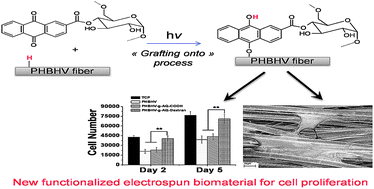Photoinduced modification of the natural biopolymer poly(3-hydroxybutyrate-co-3-hydroxyvalerate) microfibrous surface with anthraquinone-derived dextran for biological applications†
Abstract
A straightforward and versatile method for immobilizing

Maintenance work is planned for Wednesday 1st May 2024 from 9:00am to 11:00am (BST).
During this time, the performance of our website may be affected - searches may run slowly and some pages may be temporarily unavailable. If this happens, please try refreshing your web browser or try waiting two to three minutes before trying again.
We apologise for any inconvenience this might cause and thank you for your patience.
* Corresponding authors
a
Institut de Chimie et des Matériaux Paris-Est, Equipe Systèmes Polymères Complexes, UMR 7182, CNRS-Université Paris-Est Créteil Val de Marne, 2-8 rue Henri Dunant, 94320 Thiais, France
E-mail:
versace@icmpe.cnrs.fr
Fax: +33 1 49 78 12 01
Tel: +33 1 49 78 12 28
b Institut de Science des Matériaux de Mulhouse, IS2M-LRC 7228, 15 rue Starcky, 68057 Mulhouse, France
c Université Paris-Est Créteil Val de Marne, Laboratory “Croissance cellulaire, Réparation et Régénération tissulaire” (CRRET)-EAC CNRS 7149, 61, Avenue du Général de Gaulle, 94010 Créteil Cedex, France
A straightforward and versatile method for immobilizing

 Please wait while we load your content...
Something went wrong. Try again?
Please wait while we load your content...
Something went wrong. Try again?
D. Versace, J. Ramier, J. Babinot, P. Lemechko, O. Soppera, J. Lalevee, P. Albanese, E. Renard and V. Langlois, J. Mater. Chem. B, 2013, 1, 4834 DOI: 10.1039/C3TB20869A
To request permission to reproduce material from this article, please go to the Copyright Clearance Center request page.
If you are an author contributing to an RSC publication, you do not need to request permission provided correct acknowledgement is given.
If you are the author of this article, you do not need to request permission to reproduce figures and diagrams provided correct acknowledgement is given. If you want to reproduce the whole article in a third-party publication (excluding your thesis/dissertation for which permission is not required) please go to the Copyright Clearance Center request page.
Read more about how to correctly acknowledge RSC content.
 Fetching data from CrossRef.
Fetching data from CrossRef.
This may take some time to load.
Loading related content
